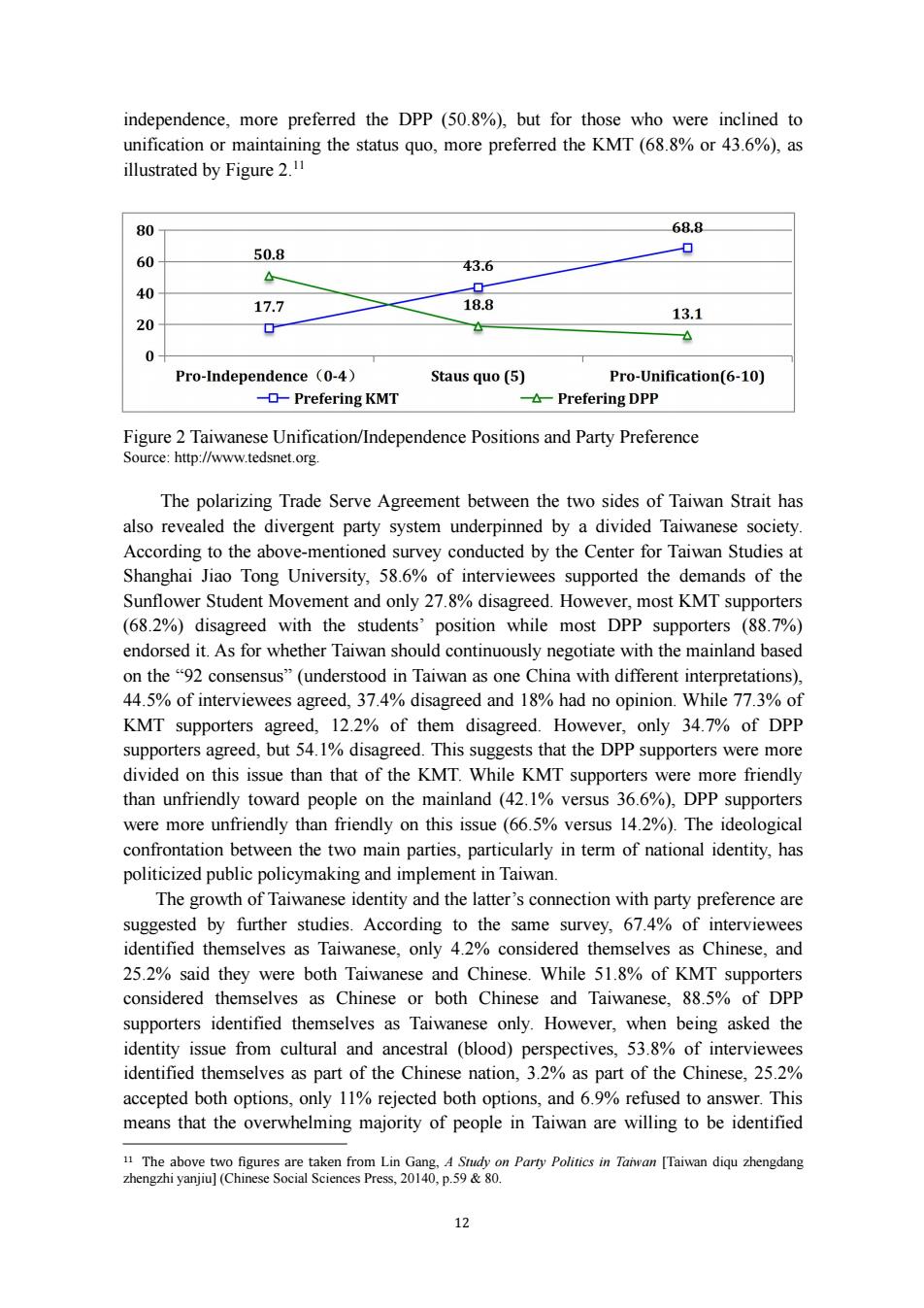正在加载图片...

independence,more preferred the DPP(50.8%),but for those who were inclined to unification or maintaining the status quo,more preferred the KMT(68.8%or 43.6%),as illustrated by Figure 2. 80 68.8 60 50.8 0 43.6 △ 40 0 17.7 18.8 20 13.1 众 4 0 Pro-Independence (0-4) Staus quo(5) Pro-Unification(6-10) D-Prefering KMT △Prefering DPP Figure 2 Taiwanese Unification/Independence Positions and Party Preference Source:http://www.tedsnet.org. The polarizing Trade Serve Agreement between the two sides of Taiwan Strait has also revealed the divergent party system underpinned by a divided Taiwanese society. According to the above-mentioned survey conducted by the Center for Taiwan Studies at Shanghai Jiao Tong University,58.6%of interviewees supported the demands of the Sunflower Student Movement and only 27.8%disagreed.However,most KMT supporters (68.2%)disagreed with the students'position while most DPP supporters (88.7%) endorsed it.As for whether Taiwan should continuously negotiate with the mainland based on the "92 consensus"(understood in Taiwan as one China with different interpretations), 44.5%of interviewees agreed,37.4%disagreed and 18%had no opinion.While 77.3%of KMT supporters agreed,12.2%of them disagreed.However,only 34.7%of DPP supporters agreed,but 54.1%disagreed.This suggests that the DPP supporters were more divided on this issue than that of the KMT.While KMT supporters were more friendly than unfriendly toward people on the mainland(42.1%versus 36.6%),DPP supporters were more unfriendly than friendly on this issue (66.5%versus 14.2%).The ideological confrontation between the two main parties,particularly in term of national identity,has politicized public policymaking and implement in Taiwan. The growth of Taiwanese identity and the latter's connection with party preference are suggested by further studies.According to the same survey,67.4%of interviewees identified themselves as Taiwanese,only 4.2%considered themselves as Chinese,and 25.2%said they were both Taiwanese and Chinese.While 51.8%of KMT supporters considered themselves as Chinese or both Chinese and Taiwanese,88.5%of DPP supporters identified themselves as Taiwanese only.However,when being asked the identity issue from cultural and ancestral (blood)perspectives,53.8%of interviewees identified themselves as part of the Chinese nation,3.2%as part of the Chinese,25.2% accepted both options,only 11%rejected both options,and 6.9%refused to answer.This means that the overwhelming majority of people in Taiwan are willing to be identified The above two figures are taken from Lin Gang,A Stdy on Party Politics in Taiwan [Taiwan diqu zhengdang zhengzhi yanjiu](Chinese Social Sciences Press,20140,p.59 80. 1212 independence, more preferred the DPP (50.8%), but for those who were inclined to unification or maintaining the status quo, more preferred the KMT (68.8% or 43.6%), as illustrated by Figure 2.11 Figure 2 Taiwanese Unification/Independence Positions and Party Preference Source: http://www.tedsnet.org. The polarizing Trade Serve Agreement between the two sides of Taiwan Strait has also revealed the divergent party system underpinned by a divided Taiwanese society. According to the above-mentioned survey conducted by the Center for Taiwan Studies at Shanghai Jiao Tong University, 58.6% of interviewees supported the demands of the Sunflower Student Movement and only 27.8% disagreed. However, most KMT supporters (68.2%) disagreed with the students’ position while most DPP supporters (88.7%) endorsed it. As for whether Taiwan should continuously negotiate with the mainland based on the “92 consensus” (understood in Taiwan as one China with different interpretations), 44.5% of interviewees agreed, 37.4% disagreed and 18% had no opinion. While 77.3% of KMT supporters agreed, 12.2% of them disagreed. However, only 34.7% of DPP supporters agreed, but 54.1% disagreed. This suggests that the DPP supporters were more divided on this issue than that of the KMT. While KMT supporters were more friendly than unfriendly toward people on the mainland (42.1% versus 36.6%), DPP supporters were more unfriendly than friendly on this issue (66.5% versus 14.2%). The ideological confrontation between the two main parties, particularly in term of national identity, has politicized public policymaking and implement in Taiwan. The growth of Taiwanese identity and the latter’s connection with party preference are suggested by further studies. According to the same survey, 67.4% of interviewees identified themselves as Taiwanese, only 4.2% considered themselves as Chinese, and 25.2% said they were both Taiwanese and Chinese. While 51.8% of KMT supporters considered themselves as Chinese or both Chinese and Taiwanese, 88.5% of DPP supporters identified themselves as Taiwanese only. However, when being asked the identity issue from cultural and ancestral (blood) perspectives, 53.8% of interviewees identified themselves as part of the Chinese nation, 3.2% as part of the Chinese, 25.2% accepted both options, only 11% rejected both options, and 6.9% refused to answer. This means that the overwhelming majority of people in Taiwan are willing to be identified 11 The above two figures are taken from Lin Gang, A Study on Party Politics in Taiwan [Taiwan diqu zhengdang zhengzhi yanjiu] (Chinese Social Sciences Press, 20140, p.59 & 80